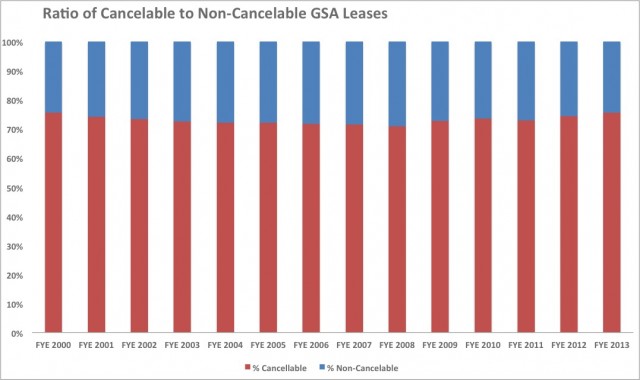
It is possible that no tenant in the United States has greater fondness for termination rights than the U.S. General Services Administration (GSA). As I pointed out in a blog article more than two years ago, GSA requests termination rights in about three-fourths of its lease procurements. The reasons are understandable: GSA leases space on behalf of other federal agencies and its Occupancy Agreement (OA) with each tenant agency typically includes a clause that allows the agency to cancel its OA with GSA at any time with just 120 days notice. In an effort to hedge its exposure, GSA will routinely seek to negotiate termination rights so that it can cancel its lease with the landlord if the tenant agency cancels its OA with GSA.
In light of the blistering and routine fiscal battles that have left agencies without appropriated budgets, limping along through a series of continuing resolutions, it’s understandable that GSA would take a cautious approach to long-term lease obligations, and so would its tenant agencies. We would expect that this is just a particularly dysfunctional phase and that the feds will eventually reboot and get back to normal business. Yet, unfortunately, this is normal business.
When we look back at more than a decade of GSA leasing we can see that at no time since 2000 did less than 71% of GSA leases contain termination rights–through two presidents and seven sessions of Congress. In times of war and peace. During prosperity and recession. Through Democratic and Republican leadership. From before the last Washington Redskins playoff victory. Even through the reign of nine GSA Public Buildings Service Commissioners.
We must conclude that this persistent problem is structural. The facts suggest that GSA is failing in its most basic role as lease negotiator because its motives are fundamentally out of alignment with those of its tenant agencies. Agencies get the best rent deal from long-term leases, yet GSA resists executing those very lease structures. This problem is costing the federal government money because termination rights aren’t free, and while GSA achieves some measure of protection for itself by negotiating uber-cancellable leases, the costs get passed through to the tenant agencies. Either GSA must adapt its leasing policy to address this reality or the agencies must be willing to relinquish their rights to terminate for convenience.
Congress is becoming hip to this. In a recent congressional hearing Rep. Lou Barletta (R-PA) challenged several agency realty officers, including the GSA Commissioner Norman Dong, to engage in leases of 10 years or more, noting that “at the most basic level, a longer lease lowers risk, lowers finance costs, and provides certainty for the landlord who can then offer lower rents” (we must assume he intended non-cancelable leases). All of these government executives acknowledged the virtues of long-term leasing yet, if history is any guide, nothing will change.
